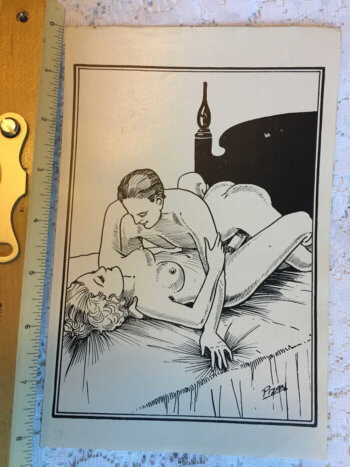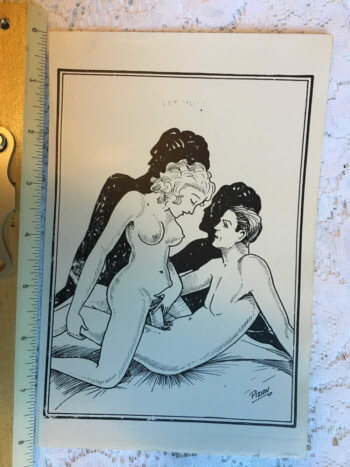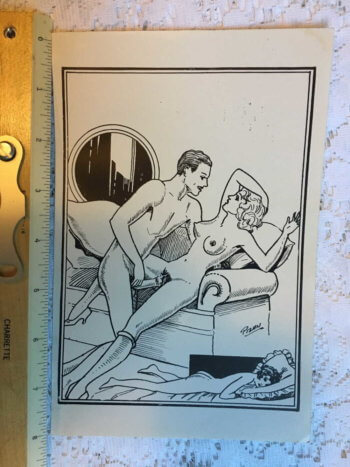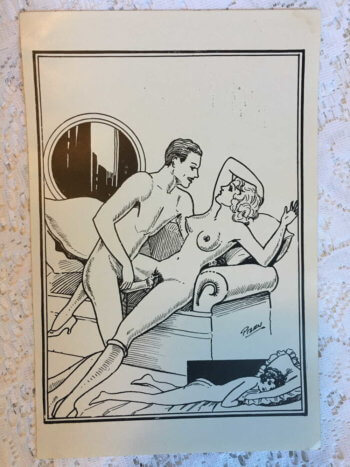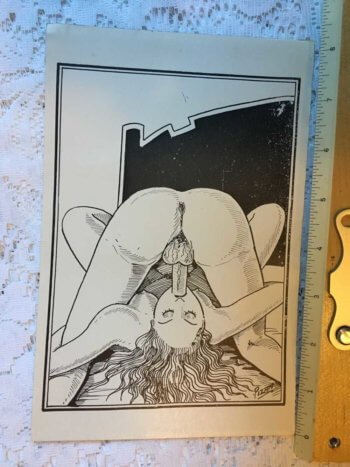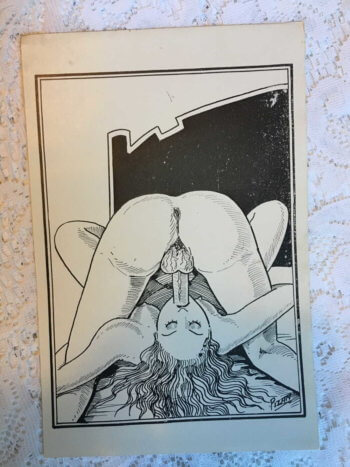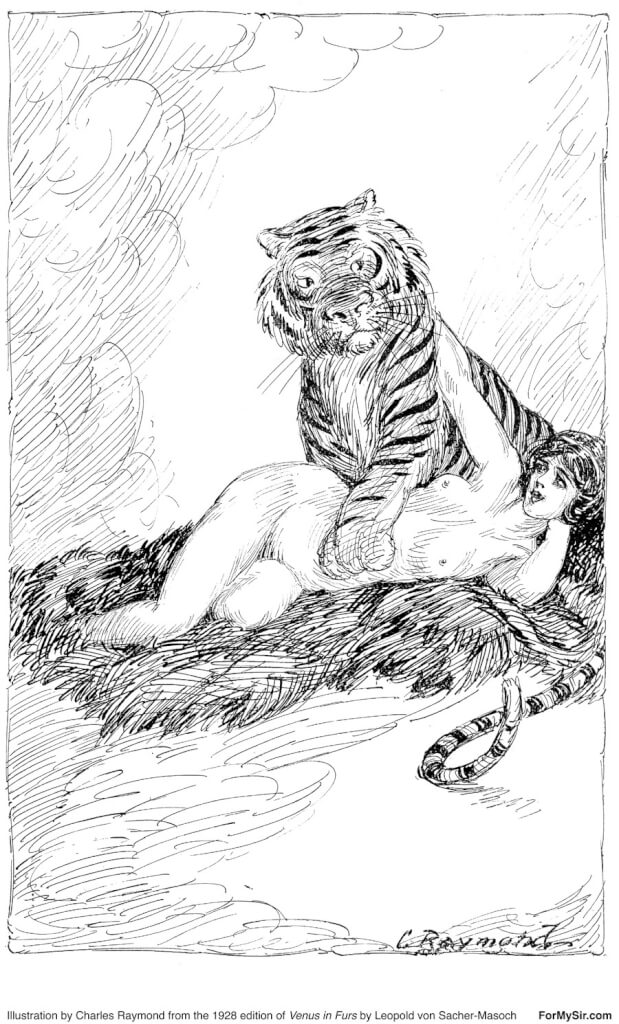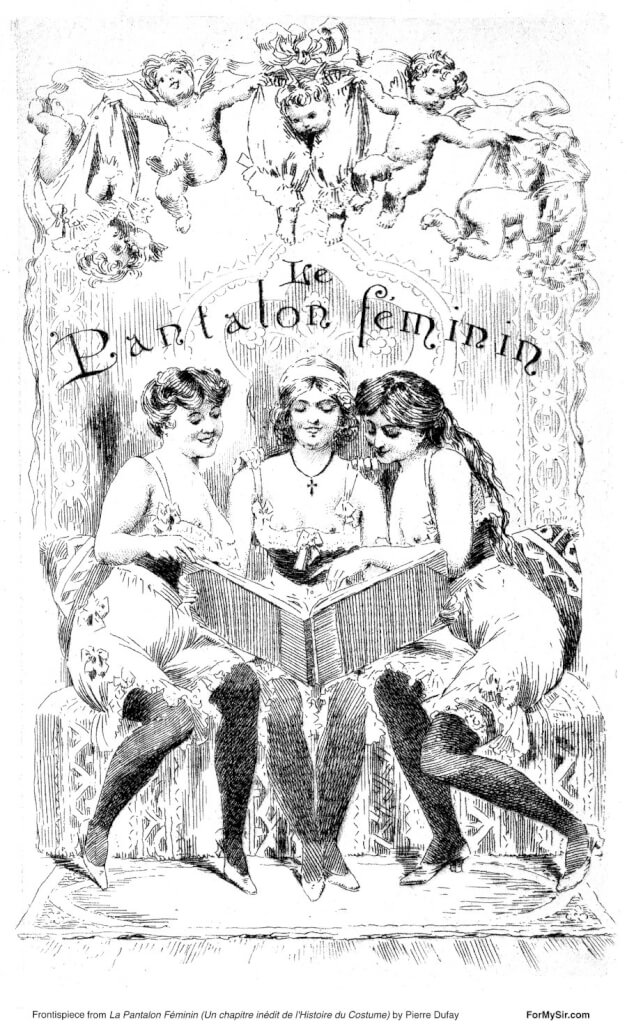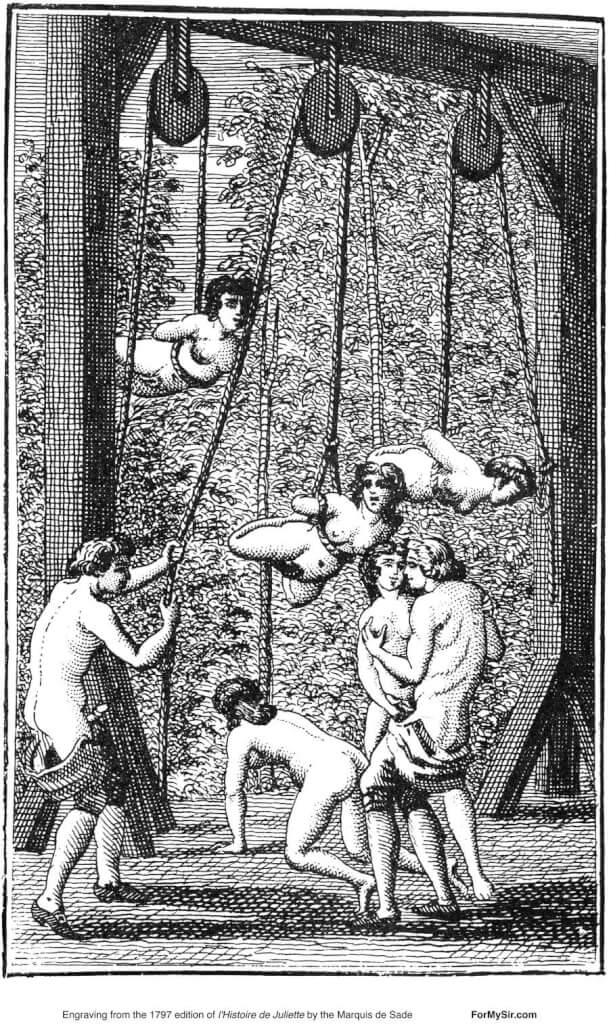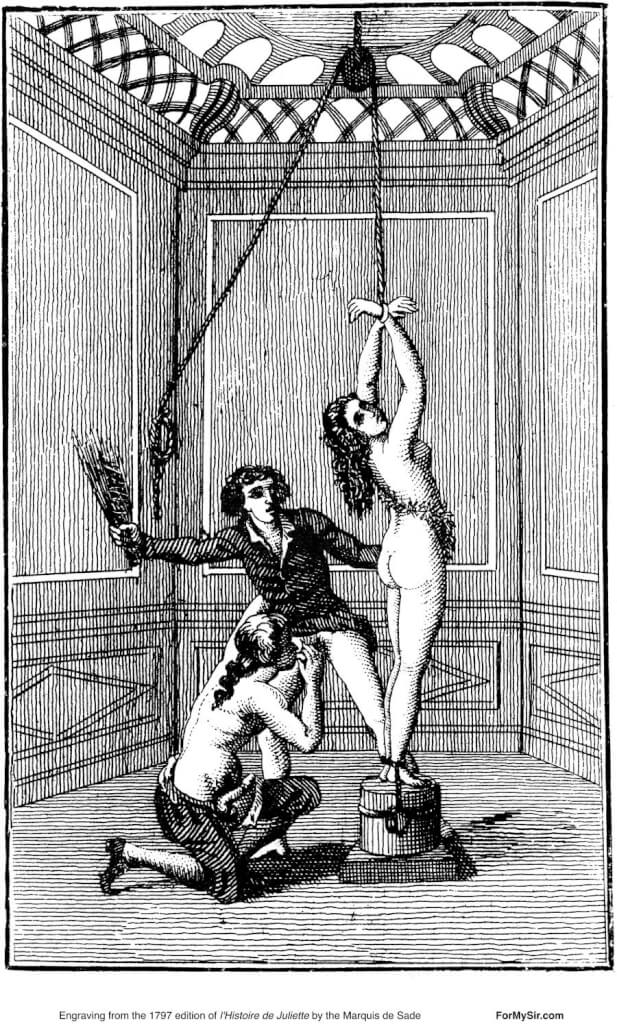-
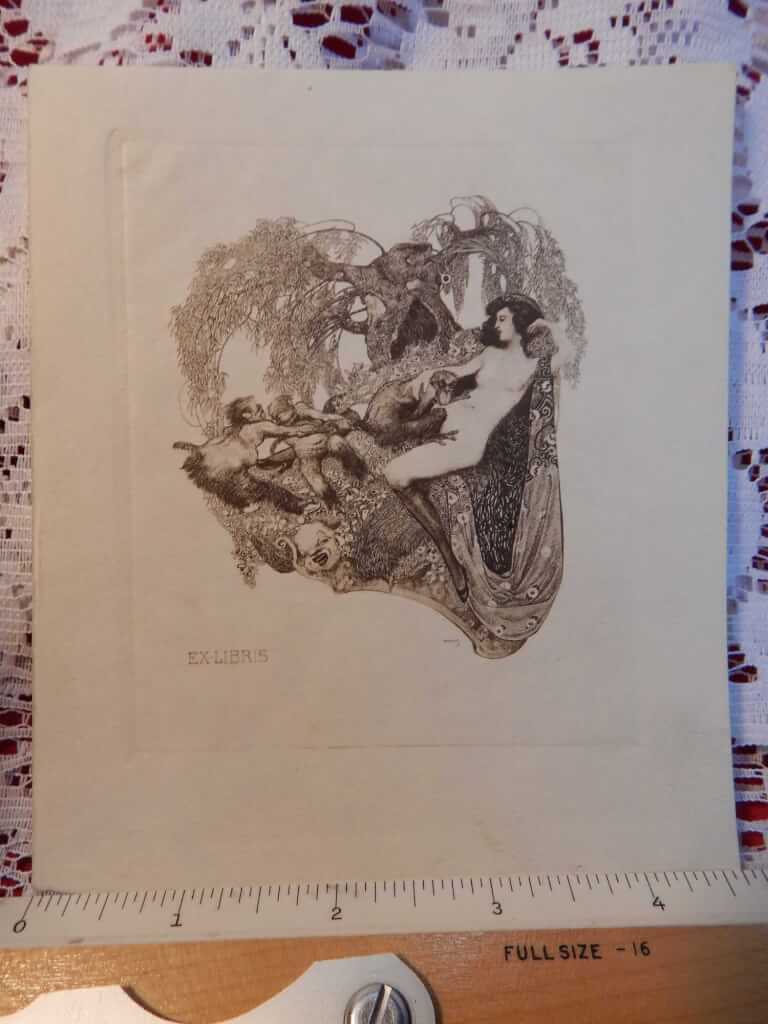 Ex Libris, by Franz von Bayros paper size 4.75 x 5.5", print size 3.5 x 4" naked woman sitting in a tree being "intimate" with monkey, other monkeys trying to pull him away from her. Very detailed and ornate. Franz von Bayros (1866 – 1924) was an Austrian commercial artist, illustrator, and painter, now he is best known for his erotic work. He belonged to the Decadent movement in art, often utilizing erotic themes and phantasmagoric imagery. At the age 17, Bayros passed the entrance exam for the Vienna Academy with Eduard von Engerth. Bayros mixed in elegant society and soon belonged to the circle of friends of Johann Straub, whose step daughter Alice he married on 1896. The next year, Bayros moved to Munich. In 1904, Bayros gave his first exhibition in Munich, which was a great success. From 1904 until 1908, Bayros traveled to Paris and Italy for his studies. Typically, for an artist dealing with such imagery, von Bayros produced work under several pseudonyms, most notably Choisy Le Conin, and was hounded by authorities for much of his life for his “indecent” art often very imaginative, and including such taboo subjects as sadomasochism and bestiality. He became equally well-known for his masterly drawn figures of elegant modestly nude and non-nude women.
Ex Libris, by Franz von Bayros paper size 4.75 x 5.5", print size 3.5 x 4" naked woman sitting in a tree being "intimate" with monkey, other monkeys trying to pull him away from her. Very detailed and ornate. Franz von Bayros (1866 – 1924) was an Austrian commercial artist, illustrator, and painter, now he is best known for his erotic work. He belonged to the Decadent movement in art, often utilizing erotic themes and phantasmagoric imagery. At the age 17, Bayros passed the entrance exam for the Vienna Academy with Eduard von Engerth. Bayros mixed in elegant society and soon belonged to the circle of friends of Johann Straub, whose step daughter Alice he married on 1896. The next year, Bayros moved to Munich. In 1904, Bayros gave his first exhibition in Munich, which was a great success. From 1904 until 1908, Bayros traveled to Paris and Italy for his studies. Typically, for an artist dealing with such imagery, von Bayros produced work under several pseudonyms, most notably Choisy Le Conin, and was hounded by authorities for much of his life for his “indecent” art often very imaginative, and including such taboo subjects as sadomasochism and bestiality. He became equally well-known for his masterly drawn figures of elegant modestly nude and non-nude women. -
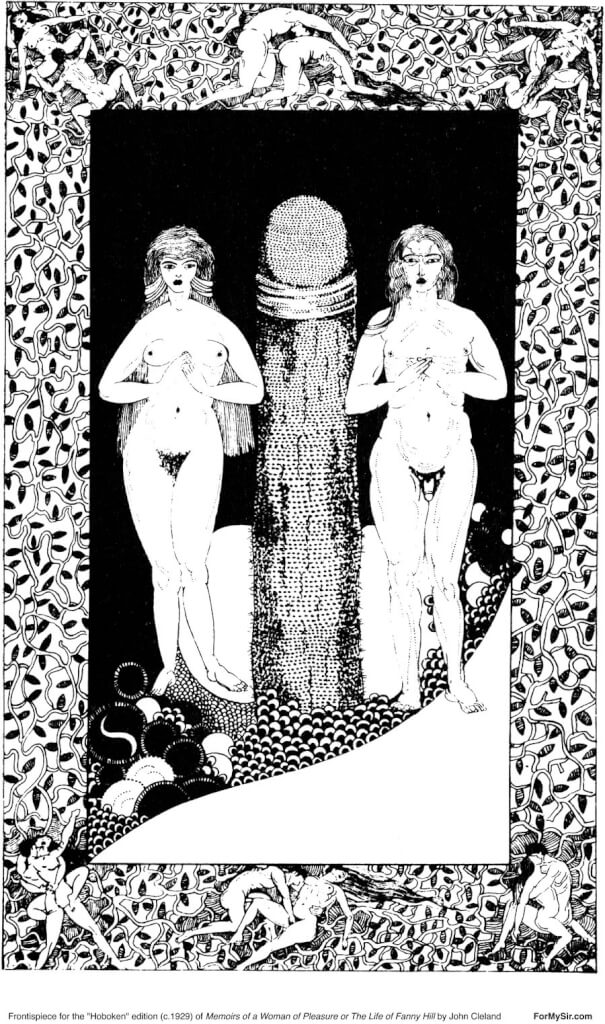 Fanny Hill (Hoboken frontispiece), artist unknown Printed from: Memoirs of a Woman of Pleasure or The Life of Fanny Hill John Cleland (Hoboken, np, 1929 [Philadelphia?] limited edition 700 (unnumbered)) Image: 6″ x 10″, high-resolution ink-jet print Paper: 8.5″ x 11″, your choice of 65lb White or 67lb Ivory Parchment
Fanny Hill (Hoboken frontispiece), artist unknown Printed from: Memoirs of a Woman of Pleasure or The Life of Fanny Hill John Cleland (Hoboken, np, 1929 [Philadelphia?] limited edition 700 (unnumbered)) Image: 6″ x 10″, high-resolution ink-jet print Paper: 8.5″ x 11″, your choice of 65lb White or 67lb Ivory Parchment -
Out of stock
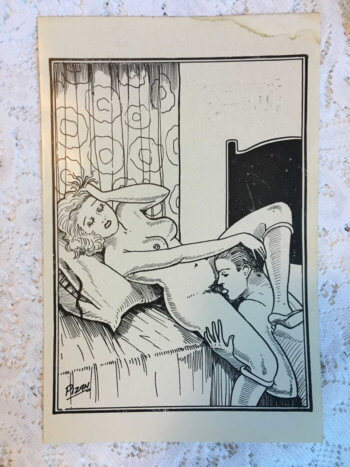
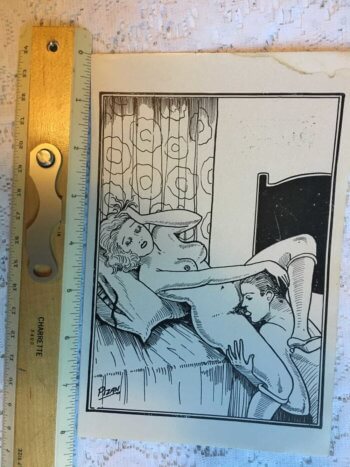 Fanny Hill print 5.5 x 8.25" This print came from someone's private collection. The rest of the prints I have from this estate are also from various editions of Fanny Hill by John Cleland. Print is by "PIZAN" and is possibly from a 20-30s edition printed clandestinely in NY.
Fanny Hill print 5.5 x 8.25" This print came from someone's private collection. The rest of the prints I have from this estate are also from various editions of Fanny Hill by John Cleland. Print is by "PIZAN" and is possibly from a 20-30s edition printed clandestinely in NY. -
Out of stock
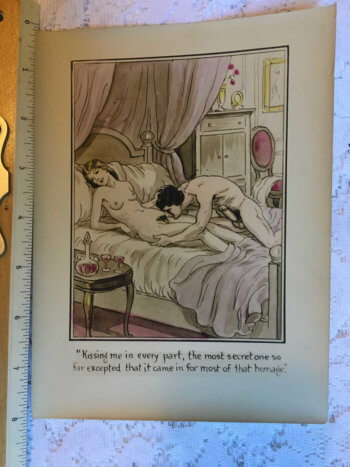
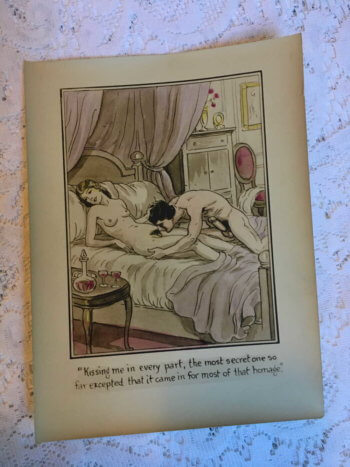 Fanny Hill print "Kissing me in every part, the most secret one so far excepted that it came in for most of that homage." 6 x 8", hand colored This print came from someone's private collection. The rest of the prints I have from this estate are also from various editions of Fanny Hill by John Cleland. I'm unsure of the edition but this seems to be a print from the 1920-30s and hand colored.
Fanny Hill print "Kissing me in every part, the most secret one so far excepted that it came in for most of that homage." 6 x 8", hand colored This print came from someone's private collection. The rest of the prints I have from this estate are also from various editions of Fanny Hill by John Cleland. I'm unsure of the edition but this seems to be a print from the 1920-30s and hand colored. -
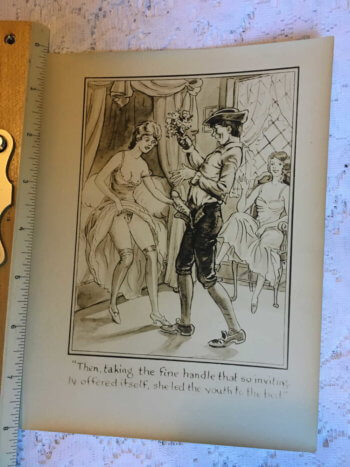
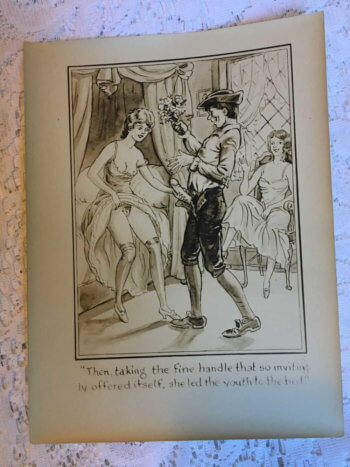 Fanny Hill print "Then, taking the fine handle that so invitingly offered itself, she led the youth to the bed." 6 x 8" This print came from someone's private collection. The rest of the prints I have from this estate are also from various editions of Fanny Hill by John Cleland. I'm unsure of the edition but this seems to be a print from the 1920-30s.
Fanny Hill print "Then, taking the fine handle that so invitingly offered itself, she led the youth to the bed." 6 x 8" This print came from someone's private collection. The rest of the prints I have from this estate are also from various editions of Fanny Hill by John Cleland. I'm unsure of the edition but this seems to be a print from the 1920-30s. -
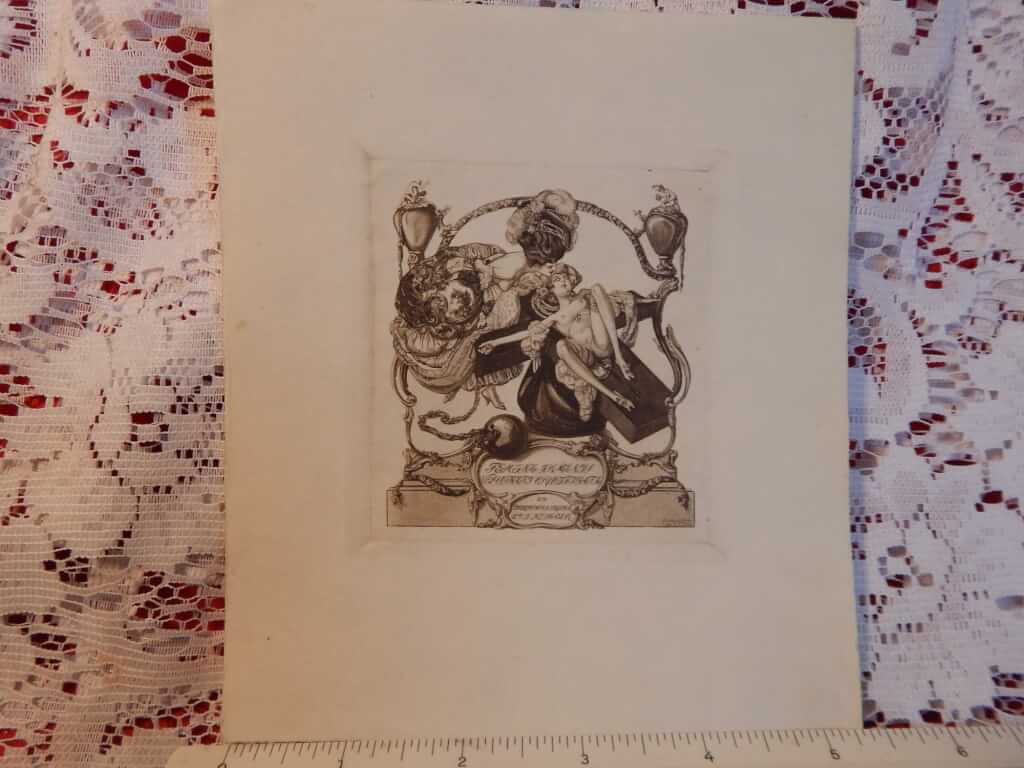 Femina Hominis Voluptati Crucifigata, Ex Bibliotheca Erotica Dr. J. Klueber, by Franz von Bayros paper size 5.5 x 6.25", print size 3.5 x 3.5" Topless handcuffed woman consoling naked girl nailed to cross. "Femina Hominis Voluptati Crucifigata" is possibly latin for "the woman is man's pleasure crucified"? The detail in this print is magnifying-glass-worthy as there are copulating couples at the top of the columns. Franz von Bayros (1866 – 1924) was an Austrian commercial artist, illustrator, and painter, now he is best known for his erotic work. He belonged to the Decadent movement in art, often utilizing erotic themes and phantasmagoric imagery. At the age 17, Bayros passed the entrance exam for the Vienna Academy with Eduard von Engerth. Bayros mixed in elegant society and soon belonged to the circle of friends of Johann Straub, whose step daughter Alice he married on 1896. The next year, Bayros moved to Munich. In 1904, Bayros gave his first exhibition in Munich, which was a great success. From 1904 until 1908, Bayros traveled to Paris and Italy for his studies. Typically, for an artist dealing with such imagery, von Bayros produced work under several pseudonyms, most notably Choisy Le Conin, and was hounded by authorities for much of his life for his “indecent” art often very imaginative, and including such taboo subjects as sadomasochism and bestiality. He became equally well-known for his masterly drawn figures of elegant modestly nude and non-nude women.
Femina Hominis Voluptati Crucifigata, Ex Bibliotheca Erotica Dr. J. Klueber, by Franz von Bayros paper size 5.5 x 6.25", print size 3.5 x 3.5" Topless handcuffed woman consoling naked girl nailed to cross. "Femina Hominis Voluptati Crucifigata" is possibly latin for "the woman is man's pleasure crucified"? The detail in this print is magnifying-glass-worthy as there are copulating couples at the top of the columns. Franz von Bayros (1866 – 1924) was an Austrian commercial artist, illustrator, and painter, now he is best known for his erotic work. He belonged to the Decadent movement in art, often utilizing erotic themes and phantasmagoric imagery. At the age 17, Bayros passed the entrance exam for the Vienna Academy with Eduard von Engerth. Bayros mixed in elegant society and soon belonged to the circle of friends of Johann Straub, whose step daughter Alice he married on 1896. The next year, Bayros moved to Munich. In 1904, Bayros gave his first exhibition in Munich, which was a great success. From 1904 until 1908, Bayros traveled to Paris and Italy for his studies. Typically, for an artist dealing with such imagery, von Bayros produced work under several pseudonyms, most notably Choisy Le Conin, and was hounded by authorities for much of his life for his “indecent” art often very imaginative, and including such taboo subjects as sadomasochism and bestiality. He became equally well-known for his masterly drawn figures of elegant modestly nude and non-nude women. -
 Flogging, artist unknown Print from: Nell in Bridewell: Description of the System of Corporal Punishment (Flagellation) in the Female Prisons of South Germany up to the year 1848 W. Reinhard, trans. W.C. Costello Ph. D. and A. R. Allinson M. A. (Psych Press [New York], 1932) Image: 7" x 10", high-resolution ink-jet print Paper: 8.5" x 11", 65lb White paper
Flogging, artist unknown Print from: Nell in Bridewell: Description of the System of Corporal Punishment (Flagellation) in the Female Prisons of South Germany up to the year 1848 W. Reinhard, trans. W.C. Costello Ph. D. and A. R. Allinson M. A. (Psych Press [New York], 1932) Image: 7" x 10", high-resolution ink-jet print Paper: 8.5" x 11", 65lb White paper -
 Held Down and Birched, artist unknown Print from: Nell in Bridewell: Description of the System of Corporal Punishment (Flagellation) in the Female Prisons of South Germany up to the year 1848 W. Reinhard, trans. W.C. Costello Ph. D. and A. R. Allinson M. A. (Psych Press [New York], 1932) Image: 7" x 10", high-resolution ink-jet print Paper: 8.5" x 11", 65lb White paper
Held Down and Birched, artist unknown Print from: Nell in Bridewell: Description of the System of Corporal Punishment (Flagellation) in the Female Prisons of South Germany up to the year 1848 W. Reinhard, trans. W.C. Costello Ph. D. and A. R. Allinson M. A. (Psych Press [New York], 1932) Image: 7" x 10", high-resolution ink-jet print Paper: 8.5" x 11", 65lb White paper -
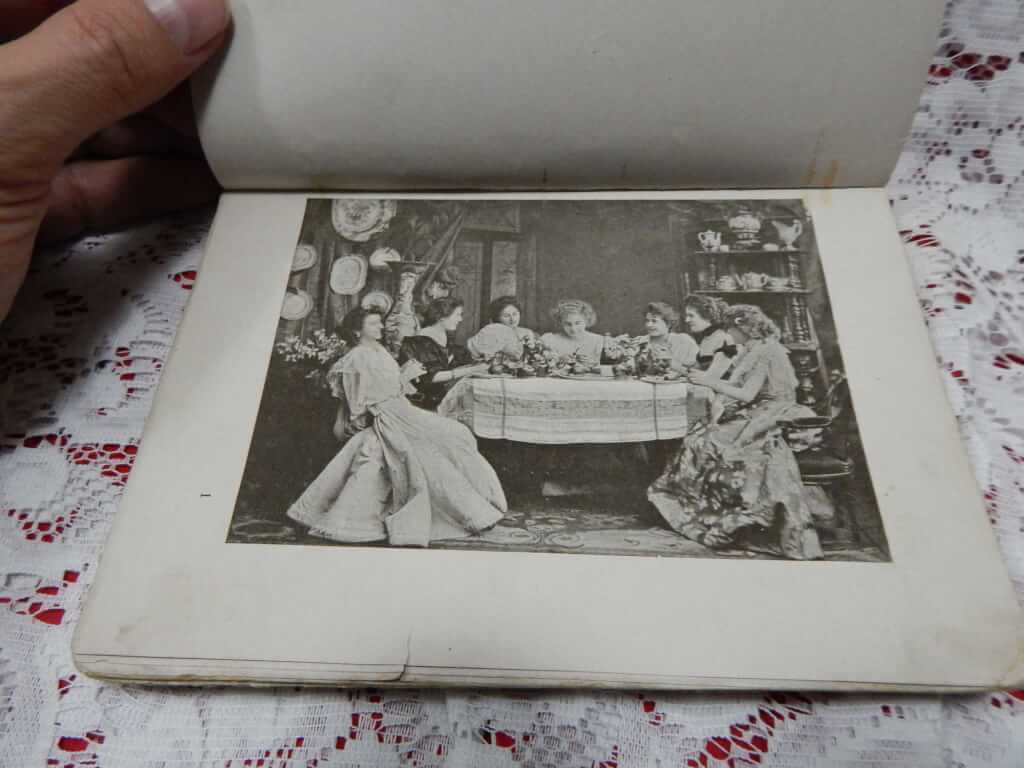
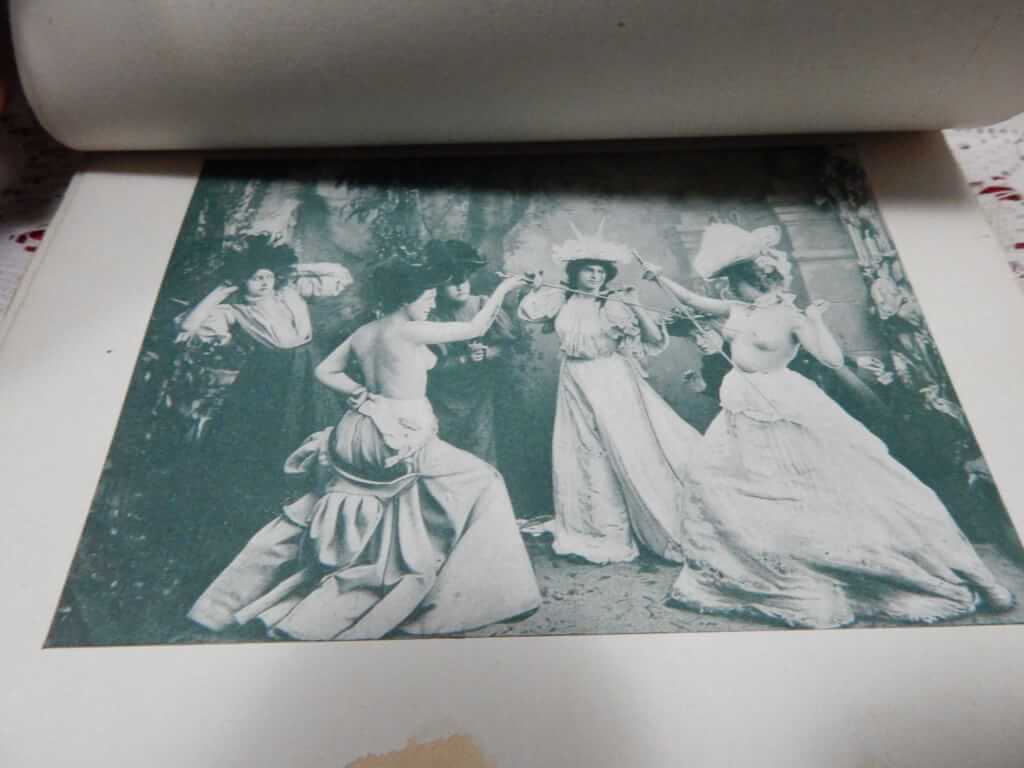 Photo Album (ca. 1900), 81 photos, 6 themed series: Le Duel (The Duel), La Deception (The Deception), Les Armurea (The Armor), La Soubrette (The Coy Soprano), Le Coucher (Going to Bed), Le Bain (The Bath), no date, no photographer, no publisher. 7.25" x 5.5", 87pp unpaginated, no boards, signatures with rivets (no longer holding) and taped together. 81 photos are grouped into 6 "photo stories". The only other marking is on the second photo and reads "SADAG, SW" The photos are elaborately staged photo. Each series starts out with the subject(s) fully clothed, but at some point becoming partially undressed. "SADAG" is "Société Anonyme des Arts Graphiques". According to books from England and France they were a "well known Geneva firm of photo engravers". The marking on the photo could mean that the the photos were processed by a member of this organization or it was processed using the techniques developed by this organization. Le Duel (14 photos) portrays a group of ladies at a lunch or tea. They start drinking and fight breaks out resulting in a duel. The duel is, of course, performed topless. In the end the winner consoles the loser. La Deception (15 photos) portrays a woman sitting in her parlor and her table is set for a two. She reads a letter/note which upsets her then angers her. She clears away the extra table setting and starts to drink wine. The more drunk she gets the less clothes she has on. In the last photo she is passed out and there are two cherubs flying around the room. In Les Armurea (11 photos) a woman is admiring two suits of armor. She undresses and puts on one of the suits of armor. La Soubrette (15 photos, roughly translated as "The Coy Soprano") a maid is cleaning up a woman's dressing room. She decides to play the soprano. She undresses, lets her hair down, uses the brush and puts on a fancy dress. Le Coucher (16 photos, "Going to Bed") is a photo story about a woman preparing for bed. Le Bain (10 photos, "The Bath") a woman prepares for and takes a bath.
Photo Album (ca. 1900), 81 photos, 6 themed series: Le Duel (The Duel), La Deception (The Deception), Les Armurea (The Armor), La Soubrette (The Coy Soprano), Le Coucher (Going to Bed), Le Bain (The Bath), no date, no photographer, no publisher. 7.25" x 5.5", 87pp unpaginated, no boards, signatures with rivets (no longer holding) and taped together. 81 photos are grouped into 6 "photo stories". The only other marking is on the second photo and reads "SADAG, SW" The photos are elaborately staged photo. Each series starts out with the subject(s) fully clothed, but at some point becoming partially undressed. "SADAG" is "Société Anonyme des Arts Graphiques". According to books from England and France they were a "well known Geneva firm of photo engravers". The marking on the photo could mean that the the photos were processed by a member of this organization or it was processed using the techniques developed by this organization. Le Duel (14 photos) portrays a group of ladies at a lunch or tea. They start drinking and fight breaks out resulting in a duel. The duel is, of course, performed topless. In the end the winner consoles the loser. La Deception (15 photos) portrays a woman sitting in her parlor and her table is set for a two. She reads a letter/note which upsets her then angers her. She clears away the extra table setting and starts to drink wine. The more drunk she gets the less clothes she has on. In the last photo she is passed out and there are two cherubs flying around the room. In Les Armurea (11 photos) a woman is admiring two suits of armor. She undresses and puts on one of the suits of armor. La Soubrette (15 photos, roughly translated as "The Coy Soprano") a maid is cleaning up a woman's dressing room. She decides to play the soprano. She undresses, lets her hair down, uses the brush and puts on a fancy dress. Le Coucher (16 photos, "Going to Bed") is a photo story about a woman preparing for bed. Le Bain (10 photos, "The Bath") a woman prepares for and takes a bath. -
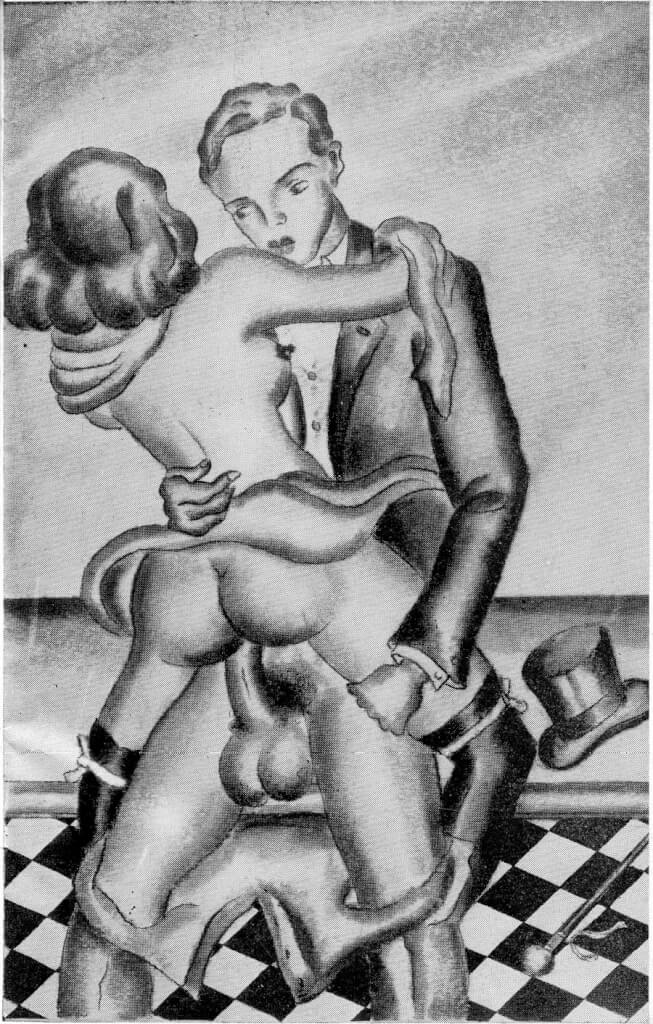 Riding a Gentleman, artist unknown Print from: The Modern Eveline; or the adventures of a young lady of quality who was never found out anonymous (Printed for Distribution Amongst Private Subscribers, Paris, 1904 [Miller Brothers, New York, c. 1930]) Image: 6.5″ x 10″, high-resolution ink-jet print Paper: 8.5″ x 11″, 65lb White paper
Riding a Gentleman, artist unknown Print from: The Modern Eveline; or the adventures of a young lady of quality who was never found out anonymous (Printed for Distribution Amongst Private Subscribers, Paris, 1904 [Miller Brothers, New York, c. 1930]) Image: 6.5″ x 10″, high-resolution ink-jet print Paper: 8.5″ x 11″, 65lb White paper -
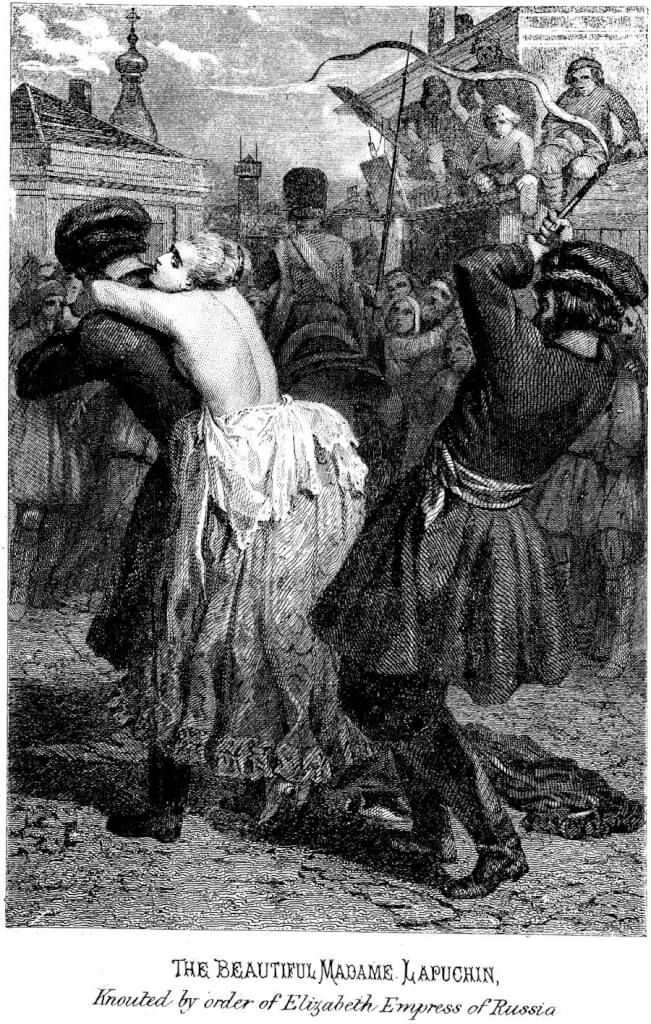 The Beautiful Madame Lapuchin, Knouted by order of Elizabeth Empress of Russia, artist unknown Print from: Flagellation & the Flagellants. A History of the Rod in All Countries from the earliest period to the present time The Rev. Wm. M. Cooper, B.A. [James Glass Bertram] (John Camden Hotten, London, n.d. [1869] (first edition)) Image: 7" x 10", high-resolution ink-jet print Paper: 8.5" x 11", your choice of 65lb White or 67lb Ivory Parchment
The Beautiful Madame Lapuchin, Knouted by order of Elizabeth Empress of Russia, artist unknown Print from: Flagellation & the Flagellants. A History of the Rod in All Countries from the earliest period to the present time The Rev. Wm. M. Cooper, B.A. [James Glass Bertram] (John Camden Hotten, London, n.d. [1869] (first edition)) Image: 7" x 10", high-resolution ink-jet print Paper: 8.5" x 11", your choice of 65lb White or 67lb Ivory Parchment -
 Venus in Furs (frontispiece), by Charles Raymond Print from: Venus in Furs Leopold von Sacher-Masoch, illus. Charles Raymond (Privately Printed for Subscribers Only, New York, 1928, #523/1250) Image: 6.5" x 10", high-resolution ink-jet print Paper: 8.5" x 11", your choice of 65lb White or 67lb Ivory Parchment
Venus in Furs (frontispiece), by Charles Raymond Print from: Venus in Furs Leopold von Sacher-Masoch, illus. Charles Raymond (Privately Printed for Subscribers Only, New York, 1928, #523/1250) Image: 6.5" x 10", high-resolution ink-jet print Paper: 8.5" x 11", your choice of 65lb White or 67lb Ivory Parchment -
 Very Large, artist unknown Print from: The Modern Eveline; or the adventures of a young lady of quality who was never found out anonymous (Printed for Distribution Amongst Private Subscribers, Paris, 1904 [Miller Brothers, New York, c. 1930]) Image: 6″ x 9″, high-resolution ink-jet print Paper: 8.5″ x 11″, 65lb White paper
Very Large, artist unknown Print from: The Modern Eveline; or the adventures of a young lady of quality who was never found out anonymous (Printed for Distribution Amongst Private Subscribers, Paris, 1904 [Miller Brothers, New York, c. 1930]) Image: 6″ x 9″, high-resolution ink-jet print Paper: 8.5″ x 11″, 65lb White paper



